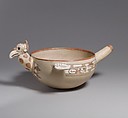Vulture Bowl
Not on view
This handsome bowl is in the shape of a vulture. Identified by the fleshy protuberance at the top of its big, curved beak, the bird's body forms the container to which the head, wings, and tail are attached. The head moves and is realistically rendered with round, hollow eyes that emerge from a strong, polka-dotted neck. A ruff of feathers painted on the wall of the vessel frames the neck as it joins the bowl. The bird's wings are worked in rudimentary fashion as grooved flanges projecting from opposite sides of the bowl, while the tail is an up-curving tube which could have served as a spout or handle. The bowl belongs to a distinctive localized ceramic style made on the Gulf Coast of Mexico during the last few centuries before the Spanish conquest in 1521. Identified with a small island situated at the entrance to the port of Veracruz, named Isla de Sacrificios by the Spaniards, who found victims of heart sacrifice there, the style typically features decorative bands in white, brown, and red on a buff-colored background.
This image cannot be enlarged, viewed at full screen, or downloaded.

